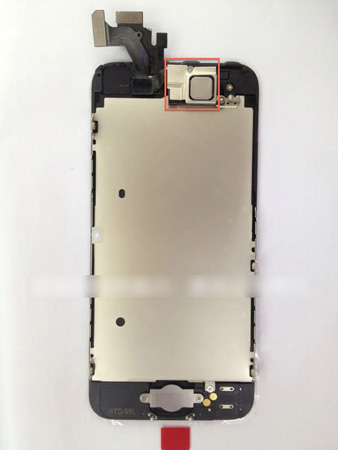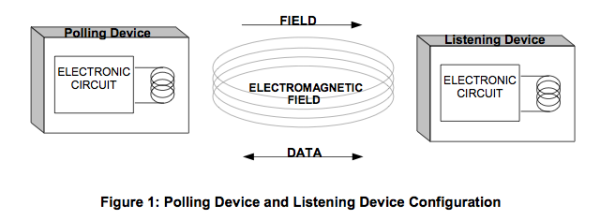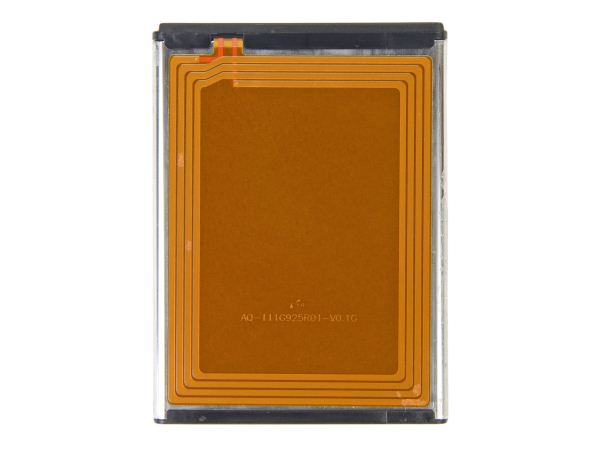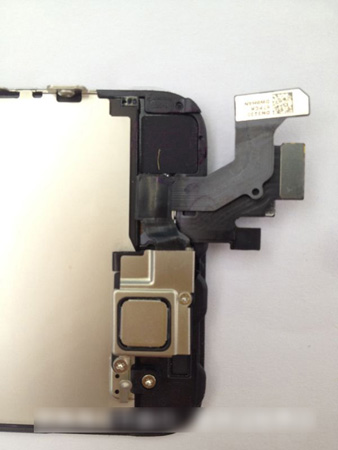Preparing for the iPhone Next: Rumors Analyzed
by Brian Klug & Anand Lal Shimpi on August 27, 2012 9:40 PM EST- Posted in
- Smartphones
- Apple
- Mobile
- iPhone
NFC, Unlikely
The most recent rumor is that this mysterious square chip (occluded by an EMI can) is an NFC combo controller and antenna, based purely on its square dimensions.

The NFC "chip" ensquared in red
Given the primarily metal backside of the new iPhone, it's highly unlikely that NFC is in the cards for this generation. In fact, given the very little space at top and bottom dedicated to those glass RF windows, you can almost entirely rule it out.
NFC operates on the 13.56MHz ISM band, which has a relatively large wavelength, at 22.1 m. Making a traditional dipole antenna that radiates at all given the constraints of a smartphone package is thus a big challenge, considering that smartphones are maybe 5-inches tall at maximum, to say nothing of the supposed upcoming iPhone's longest linear dimension.

From the NFC Forum Analog Specification
As a result almost all NFC antennas are big inductors and work using a magnetic field coupled between a host and peer device. Since we're talking about an inductor, NFC antennas use as big of a coil of wire as possible with as many wires as possible tightly wound together, and thus often use as big of an unbroken 2D plane as they can get on the device. In the smartphone space, basically all NFC antennas to date are simply flat spirals on a PCB. Whether this gets hidden on top of the battery like what Samsung has done in recent devices, or printed on the back battery cover like earlier devices, the antenna is ultimately a big square or circle with as big and dense of a coil as possible.

Galaxy Nexus Battery and NFC Antenna Coils (Courtesy iFixit)
Getting a good inductor into the device is important because how much inductance your antenna has will determine maximum coupling distance and ease of alignment. It shouldn't need saying, but having a huge ground plane (the unibody metal back case) in the way of your NFC antenna will seriously degrade performance, thus only the top or bottom windows are logical places to put it.
It's this last point which makes us very skeptical about the top or bottom RF windows being used for a relatively small NFC loop – not because such a thing is impossible – but rather because of how terrible the resulting ease of alignment and maximum coupling distance would be. Most NFC implementations at present place the inductive coils as near to the center of the device as possible, partly because this is the most optimal way to maximize the area which can be dedicated to it, partly because it makes alignment natural. With an NFC antenna at the extreme top or bottom, alignment with non-iPhones (for example, payment tokens or reader tags) becomes a much more confusing task, and that doesn't seem like the Apple-like level of polish everyone is waiting for to drive NFC adoption.

There's also a healthy number of signaling pins in the flex cable leaving the mystery chip, some of which appear to be signaling for the front facing camera which is part of the assembly, others for earpiece, proximity, and ambient light sensor. In addition this assembly also is obviously the assembled display and touch stack. When you consider the inclusion of in-cell touch sensing which has been rumored for the upcoming iPhone, and the requirement for time multiplexing of both display driving and touch sensing signals (to mitigate interference and make this possible), it's more likely that the components under that heavily shielded (and grounded with a big spring finger) EMI can are the touch and display controller combo that need to work in conjunction for in-cell to be possible.
The inclusion of Passbook in iOS 6 is the most often-cited piece of evidence for Apple including NFC, which seems a bit paradoxical since Apple hasn't disclosed at all whether it would favor NFC or a Bluetooth LE (low-energy) or even QR code based payment token through that gateway.










131 Comments
View All Comments
swb311 - Tuesday, August 28, 2012 - link
I can trust you guys to put together solid research with a realistic view for worthwhile reading. Anandtech is certainly the most reliable site on technology on the internet.FordGT550 - Tuesday, August 28, 2012 - link
Screen is too small!solarisking - Tuesday, August 28, 2012 - link
Will this device be capable of supporting VoLTE when enabled by the network?Or would that require a new or different chip?
I'm especially interested in improved voice quality that HD Voice would bring.
name99 - Tuesday, August 28, 2012 - link
Does anyone have an opinion on whether this will be the device that finally starts RF-MEMS filtering?There has been muttering about using RF-MEMS (with mechanical resonance filtering) for a few years now, and it seems like the tech should be close to ready, but I'm not yet aware of any commercialization.
The closest thing that exists is WiSpry's RF-MEMS (used in one low-volume Samsung phone that came out in early 2012), but that device seems to be basically a shrink of traditional capacitor+inductor+resistor, not based on mechanical resonance. So it's still subject to the problems of stray capacitance+inductance.
RF-MEMS, even if it costs quite a bit more, seems like a natural fit for Apple, more than any other company. In the first place it saves space, which we know Apple is obsessive about; in the second place it makes it rather easier to support a whole lot of different frequency bands (including the whole LTE band mess, and 5GHz WiFi) without the careful and painful tweaking that is necessary using traditional filters, where the inductances and capacitances from each filter spill over and mess up the nearby filters.
I could see this as a perfect Apple move. MEMS is sexy, so it makes a good "rah rah we are still at the forefront of tech innovation in phones" item for the announcement speech; it also allows the phone to more of an LTE world-phone, and if Apple has a one or two year exclusive on whoever supplies them the RF-MEMS, it makes it more difficult for someone else to ship an LTE world-phone.
FITCamaro - Tuesday, August 28, 2012 - link
http://www.youtube.com/watch?v=uIRBxRlsYR0woggs - Tuesday, August 28, 2012 - link
Just a quickly technical comment. NFC is only magnetically coupled, so isn't like a real antenna. A metal case, unless itself magnetic, won't block the magnetic field. But small size is still a limiter, so I'm not disputing the conclusion. I don't think the metal case is a limiter to NFC.worldbfree4me - Tuesday, August 28, 2012 - link
Will the new I Phone have a Barometer to assist the A-GPS for altitude awareness? Thanks in advance.debillin - Wednesday, August 29, 2012 - link
Anandtech, you are the gold standard of tech articles. I'm begging you, do not go down this road. You are above this. Apple rumors are incredibly over-reported. Leave these stories to lesser news sources.Sincerely, Annoyed longtime reader
olivdeso - Wednesday, August 29, 2012 - link
At first sight I thought this "NFC chip" was in fact a squared speaker, but now I am suspecting that it could be a pico projector...olivdeso - Wednesday, August 29, 2012 - link
or a laser 3D scanning device may be?